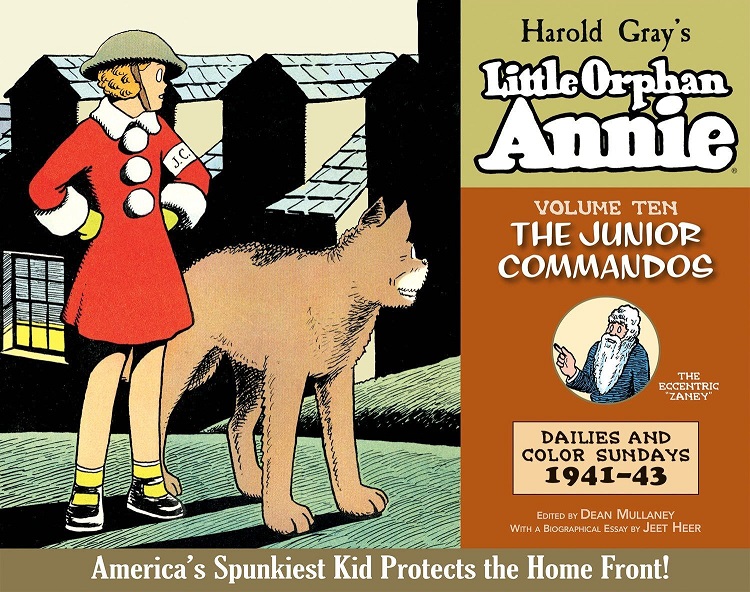
Little Orphan Annie was a daily comic strip created, written, and drawn by Harold Gray. It began in August 1924 and was finally cancelled in June 2010. Gray wrote every strip until his death in 1968 after which it was taken over by a variety of artists. At its peak, it was read by millions and in 1937 it was ranked number one in popularity by a Fortune poll. It has been adapted into a variety of other mediums, including comic books, a radio show, a Broadway musical, and a popular movie based upon the theatrical production.
Though ostensibly for children, Gray was not afraid to attach to the strip more adult themes such as organized labor, a thinly guised hatred for FDR, communism, and World War II. It is the war that features heavily in this collection. The strip was decidedly pro-war months before the U.S. got involved after Pearl Harbor, and throughout the entire war there were numerous stories involving “Daddy” Warbucks on the attack and even Annie formed a Junior Commandos league where the kids could do their part.
Interestingly, “Daddy” Warbucks (along with his band of warriors – Punjab, Asp, and others) did not fight for the U.S. Military but rather wore the uniforms of some unnamed allied power. This allowed the characters to fight their battles in any manner they saw fit, and also allowed Gray to write his stories without being under the thumb of the actual U.S. government. Other strips at the time were eager to help the war effort and in doing so found themselves as little more than propaganda machines as the government began telling them what they could and could not print.
This volume is divided into four chapters: “On Needles and Pins,” “The Junior Commandos,” “Out on a Limb,” and “The Rat Trap.” Each chapter contains roughly three separate stories. While many of the stories do get political and there is much said about the war, the strip remains true to its roots. At its heart, it is still the story of a scrappy young girl and her gruff but loving father getting into all sorts of adventures.
As someone who was really only aware of Little Orphan Annie via the 1982 film I expected the strip to follow roughly the same story-line with this cute little girl getting into wacky adventures around the house and neighborhood. I was quite surprised to see her fighting dangerous enemies across the globe and organizing a group of kids ready to face the Nazis. It makes perfect sense that a strip that lasted for decades would quickly use up the movie’s basic premise of a little orphan finding a home, I’d just never really given the concept much thought.
Reading this collection of strips, I can see why it was such a popular strip for so long. Gray’s writing is sharp and his illustrations are excellent. The adventures are a lot of fun, and while they might seem a bit hokey to modern audiences, I still expect youngsters will get a kick out of them. My only real complaint would be that the strip can get a little talkative at times and a little too often Gray fills page up with too many similar images. There are multiple strips with just faces talking and it would have been much more interesting to give us some visual variety. Mostly though, his art is striking and imaginatively drawn.
Volume Ten: The Junior Commandos is an excellent look into the heart of one of the earliest and most popular newspaper comic strips to have ever been written. It comes most highly recommended to anyone with an interest in comics.